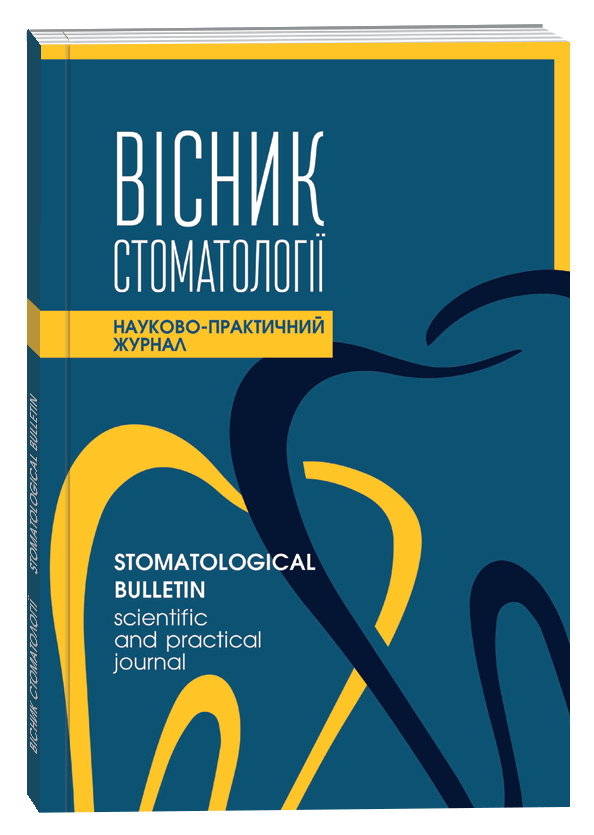FEATURES OF DIRECT PHOTOCOMPOSITION RESTORATION OF TEETH WITH DIFFERENT ENAMEL CARIES RESISTANCE
DOI:
https://doi.org/10.35220/2078-8916-2023-48-2.10Keywords:
teeth, enamel, caries resistance, etching, restoration, photocomposite materialAbstract
Purpose of the study. The aim of the study was a clinical evaluation of direct restorations of chewing teeth with viable pulp, made of photocomposite at different times of acid etching of enamel, depending on the level of its caries resistance, which was evaluated by structural and functional acid resistance. Research methods. In 105 patients, 105 chewing teeth with Black Class I cavities direct recovery using a nanohybrid photocomposite was performed. In 38 patients of group I with high and medium structural and functional acid resistance of enamel and in 36 patients of group III with low and very low acid resistance, total etching of hard dental tissues was carried out for 15 seconds, in 31 patients of group II with high and medium acid resistance, enamel was etched for 30 seconds, dentin – 15 seconds. Recovery status was assessed according to criteria related to marginal discoloration, marginal adaptation and secondary caries. Scientific novelty. After 6 months, according to the criteria of «marginal discoloration», «marginal adaptation» and «secondary caries» in patients of group I, violations were found in 3 restorations (7.89%), in patients of group II – in 2 restorations (5.56%), in group III patients – in 4 recoveries (12.90%), in 12 months, violations were found, respectively, in 7 restorations (20%), in 2 (5.88%) and 11 restorations (40.74%). Secondary caries was diagnosed only in patients of group III, according to terms, in 1 (3.23%) and 3 restored teeth (11.11%). The total number of restorations with disorders in patients of group III at 12 months was 1.6 and 5.5 times higher than in patients of group I and II, while in patients of group I of recovery with disorders it was 3.5 times more than in patients of group II, in which the time of its etching was increased due to high or medium acid resistance of enamel. To reduce the risk of complications and prolong the duration of patients restorations with a high or medium level of structural and functional acid enamel resistance, the time of enamel acid etching should be increased to 30 seconds. In patients with a low or very low level of acid resistance, an examination of the restorations condition should be carried out every 6 months, special attention should be paid to the secondary caries in the restored teeth diagnosis. Conclusions. When carrying out direct photocomposite teeth restoration, it is necessary to take into account caries resistance of enamel by structural and functional acid resistance and differentially approach the time of its etching.
References
Jing Xue Factors influencing clinical application of bulk-fill composite resin. Hua Xi Kou Qiang Yi Xue Za Zhi. 2020. Jun 1;38(3). P. 233-239. doi: 10.7518/hxkq.2020.03.001. PMID: 32573127 PMCID: PMC7296366.
Zafar MS, Ahmed N. The effects of acid etching time on surface mechanical properties of dental hard tissues. Dent Mater J. 2015. 34(3). P. 315-20. doi: 10.4012/dmj.2014-083. Epub 2015 Apr 23. PMID: 25904167.
Sofan E, Sofan A, Palaia G, Tenore G, Romeo U, Migliau G. Classification review of dental adhesive systems: from the IV generation to the universal type. Ann Stomatol (Roma). 2017. Jul 3;8(1). P. 1-17. doi: 10.11138/ads/2017.8.1.001. PMID: 28736601; PMCID: PMC5507161.
Campos M.F.T.P, Moura D.M.D., Borges B.C.D., Assuncao I.V., Caldas M.R.G.R., Platt J.A., Özcan M, Souza R.O.A.E. Influence of Acid Etching and Universal Adhesives on the Bond Strength to Dentin. Braz Dent J. 2020. Jun 31(3). P. 272-280. doi: 10.1590/0103-6440202002884. Epub 2020 Jul 13. PMID: 32667522.
Tanapitchpong R., Chunhacheevachaloke E., Ajcharanukul O. In vivo and in vitro study of enamel fluid flow in human premolars. Arch Oral Biol. 2020. Sep. P. 117:104795. doi: 10.1016/j.archoralbio.2020.104795. Epub 2020 Jun 6. PMID: 32540555.
Ajcharanukul O. Effect of the pulpal hydrostatic pressure on the morphological data of the fluid droplets emerging from dental enamel in human teeth. Data Brief. 2020. Jun 20. P. 31:105901. doi: 10.1016/j.dib.2020.105901.PMID: 32676525; PMCID: PMC7352052.
Удод О. А., Сироткіна О. В. Сучасні погляди на прогнозування карієсу зубів. Вісник проблем біології і медицини. 2012. Вип. 3, том 1 (94). С. 18-22.
Schmalz G., Ryge G. Reprint of Criteria for the clinical evaluation of dental restorative materials. Clin Oral Invest. 2005. 9. P. 215–232. https://doi.org/10.1007/s00784-005-0018-z.
Chandrasekhar V., Rudrapati L., Badami V., Tummala M. Incremental techniques in direct composite restoration. J Conserv Dent. 2017. Nov-Dec 20(6). P. 386-391. doi: 10.4103/JCD.JCD_157_16. PMID: 29430088; PMCID: PMC5799982.
Uzay Koc Vural, Arlin Kiremitçi, Saadet Gökalp Clinical Performance and Epidemiologic Aspects of Fractured Anterior Teeth Restored with a Composite Resin: A Two-Year Clinical Study. J Prosthodont. 2019. Jan 28(1). P. 204-209. doi: 10.1111/jopr.12645. PMID: 2896076.
Ожоган І. А., Герелюк В. І., Ожоган З. Р. Аналіз експертної оцінки реставрацій бічних зубів. Український стоматологічний альманах. 2014. № 4. С. 25.









